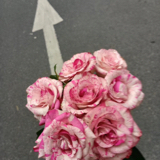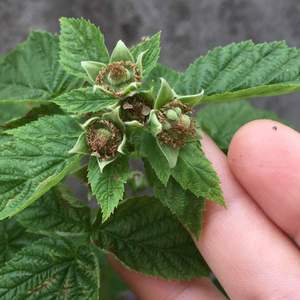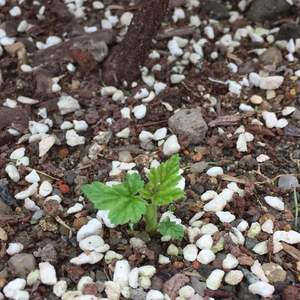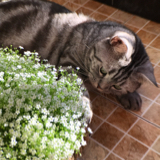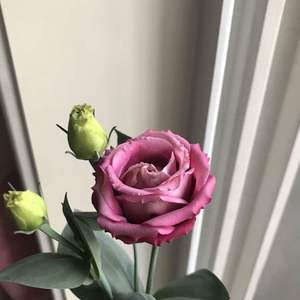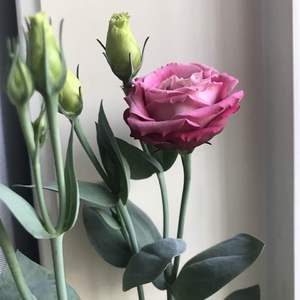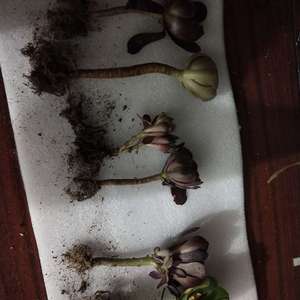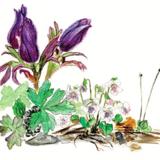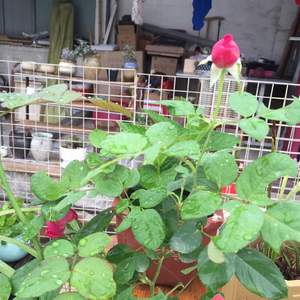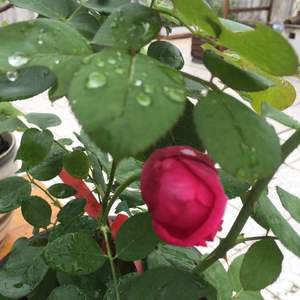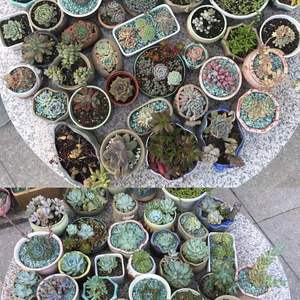文章
Miss Chen
2018年06月07日

Description: This perennial herbaceous plant has petioled basal leaves up to 6" (15 cm.) tall. The basal leaves are trifoliate and usually evergreen. The petioles of these leaves are 2-6" (5-15 cm.) long, more or less erect, light green, terete, and sparsely to moderately hairy. Individual leaflets of basal leaves are 1-3" long and a little less across; they are broadly obovate overall and wedge-shaped (cuneate) at the base. The margins of these leaflets are sharply divided (cleft) into shallow to moderately deep rounded lobes, and often slightly ciliate; the middle to outer margins are coarsely serrated or dentate. The upper leaf surface is medium to dark green (becoming dark purplish red during the winter), while the lower leaf surface is a slightly lighter shade of green. Both leaf surfaces are sparsely short-hairy. The leaflets are either sessile or they have short petiolules (basal stalklets).
Occasionally, small cymes of 3-7 flowers are produced directly from the root system. These inflorescences are about as tall as the petioled basal leaves or a little taller. The peduncle, its branches, and pedicels of an inflorescence are light green, sparsely to moderately hairy, and rather slender. Narrow leafy bracts up to ½" in length occur where the branches of the peduncle and the pedicels diverge from each other. Pedicels of the flowers are up to ½" in length. Individual flowers are ½–¾" across, consisting of 5 yellow petals, 5 light green sepals that are joined together at the base, a dense ring of 40 or more stamens with yellow anthers, and a small central cluster of 2-6 carpels with slender styles. The petals are elliptic to broadly elliptic in shape and widely spreading; they are longer than the sepals. The sepals are sparsely to moderately hairy and deltate (triangular) in shape. The blooming period usually occurs intermittently from late spring to early summer, lasting about 1 month. The petals fall from the flowers after only 1 or 2 days. Afterwards, the carpels (pistils) mature into flattened achenes about 2 mm. in length. (one achene per carpel); these achenes are finelyDistribution Map short-hairy. Prior to the maturity of the achenes, the styles break off from their achenes at the base. These styles lack hooks. The root system has shallow reddish rhizomes and secondary fibrous roots. Clonal colonies of plants of varying size are produced from the rhizomes; this is the primary method of reproduction.
Cultivation: The preference is partial sunlight to light shade, more or less mesic conditions, and soil containing rocky material, clay, loam, or humus. The soil pH should be moderately acidic to neutral (5.5–7.0). This plant dislikes hot summer weather and it requires some protection from the afternoon sun. In Illinois, areas with reduced competition from heavy leaf-fall and other ground vegetation are preferred.
Habitats: Barren Strawberry (Waldsteinia fragarioides) has been found only once in Illinois as a wild plant in Pope County, where it is regarded as a native wildflower. As a result, it has been listed as 'state-endangered.' Because this isolated population has not been relocated since its discovery, it is possible that Barren Strawberry has been extirpated from the state. The primary range of this wildflower occurs in the Appalachian Mountains and boreal areas of NE USA, the upper Midwest, and adjacent areas of southern Canada. In Illinois, this wildflower is most likely to occur in such habitats as sandstone or limestone ledges with thin layers of soil and humus, the rocky banks of woodland streams, and the rocky sides of wooded bluffs, especially if they face toward the north or east. So far, Barren Strawberry has occurred only in a high quality natural area of the state.
Faunal Associations: Very little is known about floral-faunal relationships for this wildflower. Andrenid bees (Andrena spp.) have been observed to visit the flowers for nectar and/or pollen (Krombein et al., 1979); it is likely that other small bees and other small insects visit the flowers as well. It has been reported that White-tailed Deer avoid browsing on the foliage (Hill, 2003).
Photographic Location: The wildflower garden of the webmaster in Urbana, Illinois.

Comments: The leaves of Barren Strawberry (Waldsteinia fragarioides) superficially resemble those of Wild Strawberry (Fragaria virginiana), but it produces dry achenes rather than colorful fruits and yellow flowers rather than white flowers. This native wildflower should not be confused with a very similar species that is often cultivated in ornamental gardens, namely the Siberian Barren Strawberry (Waldsteinia ternata). Many mass-market nurseries that claim to be selling the native Barren Strawberry are actually selling this latter species instead. The native Barren Strawberry differs from the latter species in the following ways: 1) its flowers have more narrow petals than the latter species, 2) there are no bractlets on its sepals, unlike the latter species, and 3) its leaflets are less deeply divided into lobes than the latter species. The light green bractlets on the sepals of Siberian Barren Strawberry are about one-third to one-half of the length of its sepals, and they are either linear or narrowly lanceolate in shape. Solitary bractlets occur between each pair of sepals. The petals of Siberian Barren Strawberry are oval to nearly orbicular in shape; adjacent petals on its flowers frequently overlap each other. Recently, some botanists have reassigned the native Barren Strawberry to another genus on the basis of genetic evidence. As a result, it is sometimes referred to as Geum fragarioides. Unlike most native Geum spp., however, the styles of native Barren Strawberry are neither persistent nor hooked. This means that animals and birds are unlikely to be important agents in the dispersal of its seeds. Another common name for this native species is Appalachian Barren Strawberry.
Occasionally, small cymes of 3-7 flowers are produced directly from the root system. These inflorescences are about as tall as the petioled basal leaves or a little taller. The peduncle, its branches, and pedicels of an inflorescence are light green, sparsely to moderately hairy, and rather slender. Narrow leafy bracts up to ½" in length occur where the branches of the peduncle and the pedicels diverge from each other. Pedicels of the flowers are up to ½" in length. Individual flowers are ½–¾" across, consisting of 5 yellow petals, 5 light green sepals that are joined together at the base, a dense ring of 40 or more stamens with yellow anthers, and a small central cluster of 2-6 carpels with slender styles. The petals are elliptic to broadly elliptic in shape and widely spreading; they are longer than the sepals. The sepals are sparsely to moderately hairy and deltate (triangular) in shape. The blooming period usually occurs intermittently from late spring to early summer, lasting about 1 month. The petals fall from the flowers after only 1 or 2 days. Afterwards, the carpels (pistils) mature into flattened achenes about 2 mm. in length. (one achene per carpel); these achenes are finelyDistribution Map short-hairy. Prior to the maturity of the achenes, the styles break off from their achenes at the base. These styles lack hooks. The root system has shallow reddish rhizomes and secondary fibrous roots. Clonal colonies of plants of varying size are produced from the rhizomes; this is the primary method of reproduction.
Cultivation: The preference is partial sunlight to light shade, more or less mesic conditions, and soil containing rocky material, clay, loam, or humus. The soil pH should be moderately acidic to neutral (5.5–7.0). This plant dislikes hot summer weather and it requires some protection from the afternoon sun. In Illinois, areas with reduced competition from heavy leaf-fall and other ground vegetation are preferred.
Habitats: Barren Strawberry (Waldsteinia fragarioides) has been found only once in Illinois as a wild plant in Pope County, where it is regarded as a native wildflower. As a result, it has been listed as 'state-endangered.' Because this isolated population has not been relocated since its discovery, it is possible that Barren Strawberry has been extirpated from the state. The primary range of this wildflower occurs in the Appalachian Mountains and boreal areas of NE USA, the upper Midwest, and adjacent areas of southern Canada. In Illinois, this wildflower is most likely to occur in such habitats as sandstone or limestone ledges with thin layers of soil and humus, the rocky banks of woodland streams, and the rocky sides of wooded bluffs, especially if they face toward the north or east. So far, Barren Strawberry has occurred only in a high quality natural area of the state.
Faunal Associations: Very little is known about floral-faunal relationships for this wildflower. Andrenid bees (Andrena spp.) have been observed to visit the flowers for nectar and/or pollen (Krombein et al., 1979); it is likely that other small bees and other small insects visit the flowers as well. It has been reported that White-tailed Deer avoid browsing on the foliage (Hill, 2003).
Photographic Location: The wildflower garden of the webmaster in Urbana, Illinois.

Comments: The leaves of Barren Strawberry (Waldsteinia fragarioides) superficially resemble those of Wild Strawberry (Fragaria virginiana), but it produces dry achenes rather than colorful fruits and yellow flowers rather than white flowers. This native wildflower should not be confused with a very similar species that is often cultivated in ornamental gardens, namely the Siberian Barren Strawberry (Waldsteinia ternata). Many mass-market nurseries that claim to be selling the native Barren Strawberry are actually selling this latter species instead. The native Barren Strawberry differs from the latter species in the following ways: 1) its flowers have more narrow petals than the latter species, 2) there are no bractlets on its sepals, unlike the latter species, and 3) its leaflets are less deeply divided into lobes than the latter species. The light green bractlets on the sepals of Siberian Barren Strawberry are about one-third to one-half of the length of its sepals, and they are either linear or narrowly lanceolate in shape. Solitary bractlets occur between each pair of sepals. The petals of Siberian Barren Strawberry are oval to nearly orbicular in shape; adjacent petals on its flowers frequently overlap each other. Recently, some botanists have reassigned the native Barren Strawberry to another genus on the basis of genetic evidence. As a result, it is sometimes referred to as Geum fragarioides. Unlike most native Geum spp., however, the styles of native Barren Strawberry are neither persistent nor hooked. This means that animals and birds are unlikely to be important agents in the dispersal of its seeds. Another common name for this native species is Appalachian Barren Strawberry.
0
0
文章
Miss Chen
2018年06月05日

Description: This perennial wildflower consists of a low rosette of basal leaves spanning about 4-6" across, from which stalks of flowers develop directly from the crown. The blades of the basal leaves are up to 2½" long and across; for var. dilatata, they are usually divided into 5-7 palmate lobes. These lobes are finger-like in shape, somewhat variable in size, and extend up to half-way into the blade. Some of the larger lobes may be subdivided into smaller lobes, and the margins of the leaf blade may have a few dentate teeth. The upper surface of each leaf blade is medium to dark green and hairless, while the lower surface is light green and hairy along the veins. The petiole of each leaf is about as long as the blade and rather stout; it is conspicuously hairy on the lower side. Individual flowers about ¾–1" across are borne at the apex of ascending stalks that are as long or longer than the leaves.
Each flower has 5 spreading petals that are deep blue-violet (2 upper, 2 lateral, and 1 lower), and 5 sepals that are light green to purple. The 2 lateral petals have dense white hairs (or beards) near the throat of the flower, while the lower petal has a conspicuous patch of white with blue-violet veins. These petals converge into a short nectar spur that is surrounded by the sepals. The sepals are lanceolate-ovate and pubescent. The stalk of each flower is densely covered with spreading white hairs; it is light green to deep purple, and nods downward at the apex where the flower occurs. The blooming period occurs during mid-spring to late spring and lasts about 2-3 weeks. During the summer, inconspicuous flowers are produced that are self-fertile; they are not pollinated by insects, unlike the spring flowers. Each fertile flower is replaced by an oblongoid capsule containing many small brown seeds. When it is ripe, this capsule divides into 3 parts, mechanically ejecting the seeds several inches or feet from the mother plant. The rootstock consists of a short stout crown with fibrous roots underneath.

Cultivation: The preference is dappled sunlight during the spring, followed by partial sun or light shade during the summer. The basal leaves die down during the fall. The soil should contain some loam and be well-drained; some rocky or gritty material is also tolerated. This plant dislikes competition from taller ground vegetation.
Range & Habitat: This variety of Cleft Violet is uncommon in the southern two-thirds of Illinois, while in the rest of the state it is rare or absent (see Distribution Map). Local populations tend to be widely scattered from each other. Habitats include dry rocky woodlands, wooded upper slopes, and thinly wooded bluffs. Oak trees are often present at these habitats. The Cleft Violet is normally found in higher quality woodlands where the original ground flora is intact.

Faunal Associations: The flower nectar of violets attracts various bees (Andrenid bees, Mason bees, etc.), bee flies (Bombylius spp.), butterflies, and skippers. The caterpillars of several Fritillary butterflies and miscellaneous moths feed on the foliage of violets (see the Butterfly & Moth Table), as do the caterpillars of Ametastegia pallipes (Violet Sawfly), which skeletonize the leaves. The insect Odontothrips pictipennis (Thrips sp.) sucks juices from violets. The leaves and stems of violets are eaten to a limited extent by the Cottontail Rabbit, Eastern Chipmunk, Wild Turkey, and Ruffed Grouse; the seeds are eaten by the Slate-Colored Junco.
Photographic Location: The wildflower garden of the webmaster in Urbana, Illinois.

Comments: This variety of Cleft Violet is one of several violets with lobed leaves. In general, it is less deeply lobed than Viola pedata (Bird's Foot Violet) and Viola pedatifida (Prairie Violet), but more strongly lobed than Viola sagittata (Arrow-Leaved Violet) and Viola fimbriatula (Sand Violet). Even for a single plant of Cleft Violet, there can be significant variation on the number of lobes and their depth for each leaf. The flowers of this species are quite similar in appearance to those of other violets with blue-violet petals. Other common names of Viola palmata are Early Blue Violet and Blue Wood Violet. A scientific synonym for this species is Viola triloba dilatata. Where their ranges overlap, this variety of Cleft Violet may intergrade with the typical variety; the latter has fewer lobes on its leaves (usually 3 or none).
Each flower has 5 spreading petals that are deep blue-violet (2 upper, 2 lateral, and 1 lower), and 5 sepals that are light green to purple. The 2 lateral petals have dense white hairs (or beards) near the throat of the flower, while the lower petal has a conspicuous patch of white with blue-violet veins. These petals converge into a short nectar spur that is surrounded by the sepals. The sepals are lanceolate-ovate and pubescent. The stalk of each flower is densely covered with spreading white hairs; it is light green to deep purple, and nods downward at the apex where the flower occurs. The blooming period occurs during mid-spring to late spring and lasts about 2-3 weeks. During the summer, inconspicuous flowers are produced that are self-fertile; they are not pollinated by insects, unlike the spring flowers. Each fertile flower is replaced by an oblongoid capsule containing many small brown seeds. When it is ripe, this capsule divides into 3 parts, mechanically ejecting the seeds several inches or feet from the mother plant. The rootstock consists of a short stout crown with fibrous roots underneath.

Cultivation: The preference is dappled sunlight during the spring, followed by partial sun or light shade during the summer. The basal leaves die down during the fall. The soil should contain some loam and be well-drained; some rocky or gritty material is also tolerated. This plant dislikes competition from taller ground vegetation.
Range & Habitat: This variety of Cleft Violet is uncommon in the southern two-thirds of Illinois, while in the rest of the state it is rare or absent (see Distribution Map). Local populations tend to be widely scattered from each other. Habitats include dry rocky woodlands, wooded upper slopes, and thinly wooded bluffs. Oak trees are often present at these habitats. The Cleft Violet is normally found in higher quality woodlands where the original ground flora is intact.

Faunal Associations: The flower nectar of violets attracts various bees (Andrenid bees, Mason bees, etc.), bee flies (Bombylius spp.), butterflies, and skippers. The caterpillars of several Fritillary butterflies and miscellaneous moths feed on the foliage of violets (see the Butterfly & Moth Table), as do the caterpillars of Ametastegia pallipes (Violet Sawfly), which skeletonize the leaves. The insect Odontothrips pictipennis (Thrips sp.) sucks juices from violets. The leaves and stems of violets are eaten to a limited extent by the Cottontail Rabbit, Eastern Chipmunk, Wild Turkey, and Ruffed Grouse; the seeds are eaten by the Slate-Colored Junco.
Photographic Location: The wildflower garden of the webmaster in Urbana, Illinois.

Comments: This variety of Cleft Violet is one of several violets with lobed leaves. In general, it is less deeply lobed than Viola pedata (Bird's Foot Violet) and Viola pedatifida (Prairie Violet), but more strongly lobed than Viola sagittata (Arrow-Leaved Violet) and Viola fimbriatula (Sand Violet). Even for a single plant of Cleft Violet, there can be significant variation on the number of lobes and their depth for each leaf. The flowers of this species are quite similar in appearance to those of other violets with blue-violet petals. Other common names of Viola palmata are Early Blue Violet and Blue Wood Violet. A scientific synonym for this species is Viola triloba dilatata. Where their ranges overlap, this variety of Cleft Violet may intergrade with the typical variety; the latter has fewer lobes on its leaves (usually 3 or none).
0
0
文章
Miss Chen
2018年06月05日

Description: This herbaceous perennial plant consists of a rosette of leaves about 6" across, from which flowering stalks develop directly from the rootstock. Each blade of a basal leaf is up to 3½" long and 2½" across, while its petiole is about as long as the blade. The leaf blades are deltoid-cordate to oval-cordate, glabrous or nearly so, palmately veined, and crenate along their margins. The petioles are rather stout, pale green, hairless or nearly so, and widely spreading to ascending. The ascending flowering stalks are about as tall as the leaves; the stalks are pale green to pale reddish green and hairless.
Each stalk nods downward at its apex and terminates in a single flower. Each flower is about ½–¾" across, consisting of 5 pale blue-violet petals and 5 pale green sepals. The lower lateral petals are bearded with white hairs near the throat of the flower; the lowest petal and upper lateral petals are beardless. The throat of the flower is white, and there are dark blue-violet veins on the lowest petal and lower lateral petals that function as nectar guides to flower-visiting insects. Sometimes the white throat of the flower is surrounded by a band of blue-violet that is slightly darker than the outer regions of the petals. At the back of each flower, there is a short blunt nectar spur. The blooming period occurs during mid- to late spring and lasts about 1½ months. Somewhat later, cleistogamous flowers are produced that are self-fertile; they lack showy petals. Each fertilized flower is replaced by a tripartite seed capsule. The small seeds in each capsule are dull light brown with oily elaisomes; they are ejected mechanically from the capsule. The root system consists of a short crown with thick rhizomes and fibrous roots. Reproduction occurs through the seeds and rhizomes.
Cultivation: The preference is light shade to partial sun, moist to mesic conditions, and a fertile loamy soil with abundant organic material.

Range & Habitat: The native Missouri Violet occurs occasionally throughout Illinois; it is more common in the southern half of the state than the northern half (see Distribution Map). Habitats include deciduous woodlands (bottomland or floodplain), woodland openings, areas along woodland paths, and rocky bluffs. The Missouri Violet doesn't occur in sunny areas to the same extent as Viola sororia sororia (Common Blue Violet) and its various color forms.
Faunal Associations: The flowers occasionally attract bees and other insects, including the oligolectic Andrena viola (Violet Andrenid Bee). These insects suck nectar from the flowers, although some of the bees collect pollen. The caterpillars of several Fritillary butterflies (Speyeria spp., Boloria spp., & Eupoieta claudia) eat the foliage of Viola spp. (Violets). Because of their oily elaisomes, the seeds are distributed in part by ants. The seeds of Violets are eaten to a limited extent by various birds and small rodents, including the Wild Turkey, Bobwhite, Mourning Dove, and White-Footed Mouse. The Wild Turkey also eats the foliage and fleshy rhizomes. Mammalian herbivores eat the foliage to a limited extent.
Photographic Location: Along a woodland path at Busey Woods in Urbana, Illinois.
Comments: The Missouri Violet is very similar to Viola sororia sororia (Common Blue Violet). It differs from the latter species in the following ways: 1) the Missouri Violet has leaf blades that are more deltoid (triangular-shaped) and less rounded than the blades of the Common Blue Violet, 2) the flowers of Missouri Violet are a lighter shade of blue-violet and slightly smaller in size than the flowers of the Common Blue Violet, and 3) the seeds of Missouri Violet are a lighter shade of brown. The Missouri Violet is even more similar to Viola sororia priceana (Confederate Violet) because their flowers are about the same shade of blue-violet. However, the Confederate Violet has more rounded leaf blades, seeds that are a darker shade of brown, and it is often found in close proximity to the Common Blue Violet, with which it freely interbreeds. The Missouri Violet is classified as a variety of Viola sororia by some authorities, in which case its scientific name is Viola sororia missouriensis.
Each stalk nods downward at its apex and terminates in a single flower. Each flower is about ½–¾" across, consisting of 5 pale blue-violet petals and 5 pale green sepals. The lower lateral petals are bearded with white hairs near the throat of the flower; the lowest petal and upper lateral petals are beardless. The throat of the flower is white, and there are dark blue-violet veins on the lowest petal and lower lateral petals that function as nectar guides to flower-visiting insects. Sometimes the white throat of the flower is surrounded by a band of blue-violet that is slightly darker than the outer regions of the petals. At the back of each flower, there is a short blunt nectar spur. The blooming period occurs during mid- to late spring and lasts about 1½ months. Somewhat later, cleistogamous flowers are produced that are self-fertile; they lack showy petals. Each fertilized flower is replaced by a tripartite seed capsule. The small seeds in each capsule are dull light brown with oily elaisomes; they are ejected mechanically from the capsule. The root system consists of a short crown with thick rhizomes and fibrous roots. Reproduction occurs through the seeds and rhizomes.
Cultivation: The preference is light shade to partial sun, moist to mesic conditions, and a fertile loamy soil with abundant organic material.

Range & Habitat: The native Missouri Violet occurs occasionally throughout Illinois; it is more common in the southern half of the state than the northern half (see Distribution Map). Habitats include deciduous woodlands (bottomland or floodplain), woodland openings, areas along woodland paths, and rocky bluffs. The Missouri Violet doesn't occur in sunny areas to the same extent as Viola sororia sororia (Common Blue Violet) and its various color forms.
Faunal Associations: The flowers occasionally attract bees and other insects, including the oligolectic Andrena viola (Violet Andrenid Bee). These insects suck nectar from the flowers, although some of the bees collect pollen. The caterpillars of several Fritillary butterflies (Speyeria spp., Boloria spp., & Eupoieta claudia) eat the foliage of Viola spp. (Violets). Because of their oily elaisomes, the seeds are distributed in part by ants. The seeds of Violets are eaten to a limited extent by various birds and small rodents, including the Wild Turkey, Bobwhite, Mourning Dove, and White-Footed Mouse. The Wild Turkey also eats the foliage and fleshy rhizomes. Mammalian herbivores eat the foliage to a limited extent.
Photographic Location: Along a woodland path at Busey Woods in Urbana, Illinois.
Comments: The Missouri Violet is very similar to Viola sororia sororia (Common Blue Violet). It differs from the latter species in the following ways: 1) the Missouri Violet has leaf blades that are more deltoid (triangular-shaped) and less rounded than the blades of the Common Blue Violet, 2) the flowers of Missouri Violet are a lighter shade of blue-violet and slightly smaller in size than the flowers of the Common Blue Violet, and 3) the seeds of Missouri Violet are a lighter shade of brown. The Missouri Violet is even more similar to Viola sororia priceana (Confederate Violet) because their flowers are about the same shade of blue-violet. However, the Confederate Violet has more rounded leaf blades, seeds that are a darker shade of brown, and it is often found in close proximity to the Common Blue Violet, with which it freely interbreeds. The Missouri Violet is classified as a variety of Viola sororia by some authorities, in which case its scientific name is Viola sororia missouriensis.
0
0
文章
Miss Chen
2018年06月05日

Description: This perennial wildflower is 6-14" tall, producing both basal and cauline leaves. The blades of both basal and cauline leaves are up to 4" long and 2½" across; they are medium to dark green, cordate or oval-cordate, palmately veined, and slightly crenate along their margins. The upper surfaces of the blades are hairless. For the typical variety of Canada Violet, the lower surfaces of the blades are largely hairless, except for fine hairs along the major veins. For var. rugulosa, these lower surfaces are more hairy. Basal leaves have longer petioles than cauline leaves. The flowering plants produce stems with alternate leaves. These stems are light green, somewhat angular, and sometimes finely pubescent. At the base of the petioles of each alternate leaf, there is a pair of linear-lanceolate stipules up to 1/3" (8 mm.) long; these stipules lack teeth.
Individual flowers are produced from the axils of the alternate leaves. The slender pedicels raise the flowers only a little above the foliage. Each flower is ½–¾" across, consisting of 5 white petals, 5 light green sepals, and a short nectar spur; the petals are much larger than the sepals. The reproductive organs are largely hidden within the throat of the flower. The lower petal has dark purple veins, while the two lateral petals have such veins to a lesser extent. The two lateral petals also have small tufts of hairs near the throat of the flower, where there is a conspicuous yellow patch. The back sides of the petals are light purple. The blooming period occurs from mid-spring to early summer and sometimes during the fall. Usually, only a few flowers are in bloom at the same time. Later in the summer, inconspicuous cleistogamous flowers are produced, which are self-fertile. Each fertile flower is replaced by an ovoid seed capsule up to ½" long. This capsule is initially green, but it later turns brown and divides into 3 segments, flinging the seeds. The root system is fibrous and either rhizomatous or stoloniferous. Colonies of plants are often produced.

Cultivation: This violet prefers dappled sunlight to light shade during the spring, but tolerates greater shade during the summer. Other cultural requirements include more or less mesic conditions, a rich soil containing loam and decaying organic matter, and cool summer temperatures.
Range & Habitat: Canada Violet is a rare wildflower that is restricted to the northern two tiers of counties in Illinois (see Distribution Map). It is state-listed as "endangered." It is native to the driftless area of NW Illinois, while populations in NE Illinois may be descendants of plants that have escaped cultivation. Habitats include mesic deciduous woodlands and bluffs. Canada Violet is normally found in high quality woodlands, although escaped cultivated plants are likely to appear in more disturbed areas.
Faunal Associations: The nectar and pollen of the flowers attract primarily bees, including bumblebees, Little Carpenter bees (Ceratina spp.), digger bees (Synhalonia spp.), Mason bees (Osmia spp.), and Andrenid bees. The Andrenid bee, Andrena violae, is an oligolectic visitor of violet flowers. Other floral visitors include bee flies and occasional skippers and butterflies. These latter insects seek nectar. The larvae of many moths and butterflies feed on the foliage of violets (see Lepidoptera Table). These larvae often hide during the day, but come out at night to feed. Other insects that feed on violets include Neotoxoptera violae (Violet Aphid), the larvae of Ametastegia pallipes (Violet Sawfly), and Odontothrips pictipennis (Thrips sp.). Among vertebrate animals, the Ruffed Grouse and Wild Turkey eat the seeds and fleshy roots. Other animals that occasionally feed on violets in wooded areas include the White-Tailed Deer (foliage), Eastern Chipmunk (stems & leaves), White-Footed Mouse (seeds), and Wood Turtle (Clemmys insculpta). However, the importance of violets as a food source to vertebrate animals is relatively low.
Photographic Location: Bob Vaiden's wildflower garden in Urbana, Illinois.

Comments: Canada Violet is somewhat similar in appearance to Viola striata (Cream Violet). It differs from the latter by the yellow patch at the throat of its flowers, petals with pale purple backsides, and toothless stipules. Other white-flowered violets in the Midwest are stemless; they produce both flowers and leaves from the crown of the root system. The leaves of Canada Violet have tips that are more slender and elongated than those of most other violets, regardless of the color of their flowers. Both the flowers and foliage are attractive.
Individual flowers are produced from the axils of the alternate leaves. The slender pedicels raise the flowers only a little above the foliage. Each flower is ½–¾" across, consisting of 5 white petals, 5 light green sepals, and a short nectar spur; the petals are much larger than the sepals. The reproductive organs are largely hidden within the throat of the flower. The lower petal has dark purple veins, while the two lateral petals have such veins to a lesser extent. The two lateral petals also have small tufts of hairs near the throat of the flower, where there is a conspicuous yellow patch. The back sides of the petals are light purple. The blooming period occurs from mid-spring to early summer and sometimes during the fall. Usually, only a few flowers are in bloom at the same time. Later in the summer, inconspicuous cleistogamous flowers are produced, which are self-fertile. Each fertile flower is replaced by an ovoid seed capsule up to ½" long. This capsule is initially green, but it later turns brown and divides into 3 segments, flinging the seeds. The root system is fibrous and either rhizomatous or stoloniferous. Colonies of plants are often produced.

Cultivation: This violet prefers dappled sunlight to light shade during the spring, but tolerates greater shade during the summer. Other cultural requirements include more or less mesic conditions, a rich soil containing loam and decaying organic matter, and cool summer temperatures.
Range & Habitat: Canada Violet is a rare wildflower that is restricted to the northern two tiers of counties in Illinois (see Distribution Map). It is state-listed as "endangered." It is native to the driftless area of NW Illinois, while populations in NE Illinois may be descendants of plants that have escaped cultivation. Habitats include mesic deciduous woodlands and bluffs. Canada Violet is normally found in high quality woodlands, although escaped cultivated plants are likely to appear in more disturbed areas.
Faunal Associations: The nectar and pollen of the flowers attract primarily bees, including bumblebees, Little Carpenter bees (Ceratina spp.), digger bees (Synhalonia spp.), Mason bees (Osmia spp.), and Andrenid bees. The Andrenid bee, Andrena violae, is an oligolectic visitor of violet flowers. Other floral visitors include bee flies and occasional skippers and butterflies. These latter insects seek nectar. The larvae of many moths and butterflies feed on the foliage of violets (see Lepidoptera Table). These larvae often hide during the day, but come out at night to feed. Other insects that feed on violets include Neotoxoptera violae (Violet Aphid), the larvae of Ametastegia pallipes (Violet Sawfly), and Odontothrips pictipennis (Thrips sp.). Among vertebrate animals, the Ruffed Grouse and Wild Turkey eat the seeds and fleshy roots. Other animals that occasionally feed on violets in wooded areas include the White-Tailed Deer (foliage), Eastern Chipmunk (stems & leaves), White-Footed Mouse (seeds), and Wood Turtle (Clemmys insculpta). However, the importance of violets as a food source to vertebrate animals is relatively low.
Photographic Location: Bob Vaiden's wildflower garden in Urbana, Illinois.

Comments: Canada Violet is somewhat similar in appearance to Viola striata (Cream Violet). It differs from the latter by the yellow patch at the throat of its flowers, petals with pale purple backsides, and toothless stipules. Other white-flowered violets in the Midwest are stemless; they produce both flowers and leaves from the crown of the root system. The leaves of Canada Violet have tips that are more slender and elongated than those of most other violets, regardless of the color of their flowers. Both the flowers and foliage are attractive.
0
0
文章
Miss Chen
2018年06月05日

Description: This woody shrub is 2-6' tall, branching occasionally. The bark of the trunk and larger branches is gray and slightly rough, while the bark of the small branches and twigs is gray or gray-brown and more smooth. Opposite pairs of leaves develop from new growth. These leaves are up to 5" long and 4" across; they are usually 3-lobed (less often unlobed), coarsely dentate, and approximately oval in shape. The lobes of the leaves have pointed tips, while the leaf bases are cordate or rounded. The upper leaf surface is medium green and hairless, while the lower surface is pale green and pubescent. The leaf petioles are pale green and pubescent. At the base of each petiole, there is usually a pair of small linear stipules, which may wither away with age.
The flat-headed panicles (or compound cymes) of flowers develop from young branches. Individual panicles span about 1½–3" across. Individual flowers are about ¼" across, consisting of a white corolla with 5 petaloid lobes, a short green calyx with 5 small teeth, 5 strongly exerted stamens, and a central pistil. The blooming period occurs from late spring to mid-summer and lasts about 3 weeks. The flowers are replaced by ovoid-globoid berries about ¼" long that become blue-black at maturity. Each berry contains a single seed (or stone). The root system is woody and branching. During the fall, the leaves can assume different colors, including pink, magenta, red, or orange.
Cultivation: The preference is dappled sunlight to light shade, mesic to dry conditions, and a somewhat acidic soil that is rocky or sandy. This shrub will adapt to fertile loamy soil, but it is more likely to be displaced by taller shrubs.
Range & Habitat: The native Maple-Leaved Viburnum is occasional in northeast Illinois, while in the rest of the state it is rare or absent (see Distribution Map). Habitats include upland rocky woodlands, upland sandy woodlands, stabilized sand dunes with woody vegetation, and rocky wooded slopes. This is an understory plant in high quality wooded habitats where the shade is not too dense.

Faunal Associations: The nectar and pollen of the flowers attract Halictid bees, Andrenid bees, miscellaneous other bees, Syrphid flies, dance flies (Empididae), and miscellaneous other flies. To a lesser extent, the flowers are also visited by wasps, beetles, butterflies, and skippers. The caterpillars of several moths feed on Viburnums (primarily the foliage); see the Moth Table for a listing of these species. Other insect feeders include the caterpillars of the butterfly Celastrina argiolus (Spring/Summer Azure), the introduced Pyrrhalta viburni (Viburnum Leaf Beetle), the wood-boring larvae of Oberea deficiens (Long-Horned Beetle sp.) and Oberea tripunctata (Dogwood Twig Borer), and several aphid species. Viburnum berries are eaten by the Ruffed Grouse and many woodland songbirds (see Bird Table). To a lesser extent, these berries are also eaten by the White-Footed Mouse, Woodland Deer Mouse, Eastern Chipmunk, and various tree squirrels. White-Tailed Deer may browse on the twigs and leaves.
Photographic Location: An upland rocky woodland at the Portland Arch in west-central Indiana, where sandstone lies at or near the ground surface.

Comments: This is one of the smallest Viburnum spp., rarely exceeding 6' in height. The other small Viburnum sp. in Illinois, Viburnum rafinesquianum (Downy Arrow-Wood), has smaller leaves that lack pointed lobes. The only other native species in this genus that has pointed lobed leaves, Viburnum trilobum (American Cranberry Bush), has sterile white flowers that are much larger in size than the fertile flowers in the center of each inflorescence. There is also a very similar European species, Viburnum opulus (European Cranberry Bush), that also produces large sterile flowers; this latter species occasionally escapes from cultivation. The mature berries of these latter two species are shiny red. In contrast, Maple-Leaved Viburnum lacks such sterile flowers, and its mature berries are blue-black.
The flat-headed panicles (or compound cymes) of flowers develop from young branches. Individual panicles span about 1½–3" across. Individual flowers are about ¼" across, consisting of a white corolla with 5 petaloid lobes, a short green calyx with 5 small teeth, 5 strongly exerted stamens, and a central pistil. The blooming period occurs from late spring to mid-summer and lasts about 3 weeks. The flowers are replaced by ovoid-globoid berries about ¼" long that become blue-black at maturity. Each berry contains a single seed (or stone). The root system is woody and branching. During the fall, the leaves can assume different colors, including pink, magenta, red, or orange.
Cultivation: The preference is dappled sunlight to light shade, mesic to dry conditions, and a somewhat acidic soil that is rocky or sandy. This shrub will adapt to fertile loamy soil, but it is more likely to be displaced by taller shrubs.
Range & Habitat: The native Maple-Leaved Viburnum is occasional in northeast Illinois, while in the rest of the state it is rare or absent (see Distribution Map). Habitats include upland rocky woodlands, upland sandy woodlands, stabilized sand dunes with woody vegetation, and rocky wooded slopes. This is an understory plant in high quality wooded habitats where the shade is not too dense.

Faunal Associations: The nectar and pollen of the flowers attract Halictid bees, Andrenid bees, miscellaneous other bees, Syrphid flies, dance flies (Empididae), and miscellaneous other flies. To a lesser extent, the flowers are also visited by wasps, beetles, butterflies, and skippers. The caterpillars of several moths feed on Viburnums (primarily the foliage); see the Moth Table for a listing of these species. Other insect feeders include the caterpillars of the butterfly Celastrina argiolus (Spring/Summer Azure), the introduced Pyrrhalta viburni (Viburnum Leaf Beetle), the wood-boring larvae of Oberea deficiens (Long-Horned Beetle sp.) and Oberea tripunctata (Dogwood Twig Borer), and several aphid species. Viburnum berries are eaten by the Ruffed Grouse and many woodland songbirds (see Bird Table). To a lesser extent, these berries are also eaten by the White-Footed Mouse, Woodland Deer Mouse, Eastern Chipmunk, and various tree squirrels. White-Tailed Deer may browse on the twigs and leaves.
Photographic Location: An upland rocky woodland at the Portland Arch in west-central Indiana, where sandstone lies at or near the ground surface.

Comments: This is one of the smallest Viburnum spp., rarely exceeding 6' in height. The other small Viburnum sp. in Illinois, Viburnum rafinesquianum (Downy Arrow-Wood), has smaller leaves that lack pointed lobes. The only other native species in this genus that has pointed lobed leaves, Viburnum trilobum (American Cranberry Bush), has sterile white flowers that are much larger in size than the fertile flowers in the center of each inflorescence. There is also a very similar European species, Viburnum opulus (European Cranberry Bush), that also produces large sterile flowers; this latter species occasionally escapes from cultivation. The mature berries of these latter two species are shiny red. In contrast, Maple-Leaved Viburnum lacks such sterile flowers, and its mature berries are blue-black.
0
0
文章
Miss Chen
2018年05月29日

Description: This perennial plant is 2½–6" tall and unbranched. It produces a single glabrous stem that terminates in a whorl of 3 leaves. The stem is light green, sometimes with reddish brown tints. The leaves are up to 2½" long; they are green or olive green, oval to ovate, hairless, and smooth along the margins. Their leaf venation is parallel. The base of each leaf is more rounded than its tip; it has a short petiole. Mature plants produce a single flower on a short peduncle about ½" long that is straight or arching (usually the latter).
The flower is up to 2" across, consisting of 3 white petals, 3 green sepals, 6 yellow stamens, and a a tripartite style. The petals are oval-ovate and often slightly undulate along their margins. The recurved sepals are lanceolate and often slightly reddish or yellowish on the outer surface. The blooming period occurs during early to mid-spring and lasts about 2 weeks. Each fertilized flower is replaced by a 3-lobed fruit that is about ½" long. The root system consists of a thickened rootstock, secondary feeder roots, and rhizomes. Snow Trillium can reseed itself, but it more often produces vegetative clones from the rhizomes. At favorable sites, colonies are often formed.

Cultivation: The preference is filtered sunlight during the spring (before the trees leaf out), and light shade during the summer. The soil should be mesic to dry, and loamy or rocky with a shallow layer of decaying leaves. There should not be too much competition from other ground layer plants during the late spring or the summer. The foliage withers away by the end of summer.
Range & Habitat: The native Snow Trillium occurs in central and northern Illinois, where it is rather uncommon (see Distribution Map). However, it is locally common at a few high quality sites. Habitats include thinly wooded bluffs, upper slopes of bluffs (especially along rivers), and upper banks of rivers. This is an indicator species of high quality woodlands. It grows where the layer of decaying leaves is not too thick.

Faunal Associations: Very few insects visit the early-blooming flowers for nectar or pollen. Most likely, the flowers are pollinated by Andrenid bees (Andrena spp.), queen bumblebees, and other bees that become active early in the spring. The caterpillars of two polyphagous moths, Clepsis melaleucana (Black-Patched Clepsis) and Euplexia benesimilis (American Angle Shades), feed on trilliums (Trillium spp.) occasionally. The fruits are probably eaten by small mammals and birds, although there is a lack of information regarding the particular species that do this. Such animals can help to introduce the seeds into new areas. Deer are very partial to the foliage of trilliums, although the Snow Trillium may be less vulnerable to their browsing than others because of its small size and strong tendency to grow on inaccessible slopes.

Photographic Location: The slope of a bluff in Vermilion County, Illinois, and a river bank at Allerton Park in Piatt County, Illinois.
Comments: This is one of the earliest wildflowers to bloom in woodlands and it is the smallest trillium (Trillium sp.). The Snow Trillium can be distinguished from other white-flowered Trilliums by considering the following features: 1) It is only 2-4" tall while in bloom, 2) it blooms earlier in the spring than other trilliums, 3) it has white flowers on a short stalk that is erect or arching, and 4) each fruit has 3 conspicuous lobes. The common name refers to the fact that snow can be found on the ground when the flowers bloom. This cute little trillium should be protected wherever it is found.
The flower is up to 2" across, consisting of 3 white petals, 3 green sepals, 6 yellow stamens, and a a tripartite style. The petals are oval-ovate and often slightly undulate along their margins. The recurved sepals are lanceolate and often slightly reddish or yellowish on the outer surface. The blooming period occurs during early to mid-spring and lasts about 2 weeks. Each fertilized flower is replaced by a 3-lobed fruit that is about ½" long. The root system consists of a thickened rootstock, secondary feeder roots, and rhizomes. Snow Trillium can reseed itself, but it more often produces vegetative clones from the rhizomes. At favorable sites, colonies are often formed.

Cultivation: The preference is filtered sunlight during the spring (before the trees leaf out), and light shade during the summer. The soil should be mesic to dry, and loamy or rocky with a shallow layer of decaying leaves. There should not be too much competition from other ground layer plants during the late spring or the summer. The foliage withers away by the end of summer.
Range & Habitat: The native Snow Trillium occurs in central and northern Illinois, where it is rather uncommon (see Distribution Map). However, it is locally common at a few high quality sites. Habitats include thinly wooded bluffs, upper slopes of bluffs (especially along rivers), and upper banks of rivers. This is an indicator species of high quality woodlands. It grows where the layer of decaying leaves is not too thick.

Faunal Associations: Very few insects visit the early-blooming flowers for nectar or pollen. Most likely, the flowers are pollinated by Andrenid bees (Andrena spp.), queen bumblebees, and other bees that become active early in the spring. The caterpillars of two polyphagous moths, Clepsis melaleucana (Black-Patched Clepsis) and Euplexia benesimilis (American Angle Shades), feed on trilliums (Trillium spp.) occasionally. The fruits are probably eaten by small mammals and birds, although there is a lack of information regarding the particular species that do this. Such animals can help to introduce the seeds into new areas. Deer are very partial to the foliage of trilliums, although the Snow Trillium may be less vulnerable to their browsing than others because of its small size and strong tendency to grow on inaccessible slopes.

Photographic Location: The slope of a bluff in Vermilion County, Illinois, and a river bank at Allerton Park in Piatt County, Illinois.
Comments: This is one of the earliest wildflowers to bloom in woodlands and it is the smallest trillium (Trillium sp.). The Snow Trillium can be distinguished from other white-flowered Trilliums by considering the following features: 1) It is only 2-4" tall while in bloom, 2) it blooms earlier in the spring than other trilliums, 3) it has white flowers on a short stalk that is erect or arching, and 4) each fruit has 3 conspicuous lobes. The common name refers to the fact that snow can be found on the ground when the flowers bloom. This cute little trillium should be protected wherever it is found.
0
0
文章
Miss Chen
2018年05月28日

Description: This perennial wildflower is 2-6' tall and usually unbranched, except toward the apex where the flowerheads occur. The glabrous central stem is light green to purple. The alternate leaves are up to 8" long and 6" across (excluding the petioles), becoming gradually smaller as they ascend the central stem. They are quite variable in shape; the lower leaves are often divided palmately into 3 lobes (or less often 5 lobes), while the upper leaves often lack lobes (ovate or deltoid). The margins of the leaves are undulate, dentate, or entire (smooth). The upper surface of each leaf is medium to dark green and hairless, becoming yellowish green with age. The petioles are as long as the leaf blades or somewhat shorter. The foliage of this plant contains a white latex.
The central stem terminates in a panicle of flowerheads that is about as wide as it is tall; smaller panicles often develop from the axils of the upper leaves. The typical panicle will have 2-4 widely spreading branches at the apex of a central stalk (peduncle); from each of these branches, several flowerheads and their buds hang downward from shorter branches (pedicels). These branches are hairless or slightly pubescent and light green to pale purple. Each flowerhead is up to ¾" long and ½" across when it is fully open; it has 5-6 outer ray florets and no disk florets. The ray florets are greenish white, cream-colored, or greenish yellow. The cylindrical base of each flowerhead has about 5 primary bracts (phyllaries) that are light green and hairless; each of these bracts is linear in shape and about ½" in length. At the very bottom of each flowerhead, there are also several secondary bracts that are much shorter than the primary bracts. The blooming period occurs from late summer into the fall and lasts about a month. Each ray floret is replaced by an achene with a small tuft of hair; these hairs are either light tan (var. altissima) or orange-brown (var. cinnamomea). The achenes are distributed by the wind. The root system is tuberous. Sometimes this species forms small colonies of plants.

Cultivation: Preferred growing conditions consist of light shade to dappled sunlight and fertile loamy soil that is moist to slightly dry. Rocky or sandy soil is also tolerated. The size of individual plants can be highly variable depending on soil fertility, moisture conditions, and light levels.
Range & Habitat: The native Tall White Lettuce is occasional in southern and extreme eastern Illinois, otherwise it is rare or absent (see Distribution Map). This species is more common further to the east. Habitats include rich mesic woodlands, rocky upland woodlands, sandy woodlands, bluffs and shaded ravines, woodland borders, swamps and seeps, and shaded to partially shaded riverbanks. This species is found in deciduous woodlands where Sugar Maple, American Basswood, and/or American Beech are often present as canopy trees.
Faunal Associations: Information about floral-faunal relationships for this species is limited. Bumblebees suck nectar from the flowerheads and cross-pollinate them; Halictid bees, beetles, and other insects may feed on the pollen, but they are not effective pollinators. Even though it has a bitter taste, White-Tailed Deer occasionally browse on the foliage.

Photographic Location: A deciduous woodland at Turkey Run State Park in west-central Indiana.
Comments: Two major groups of woodland lettuce can be found in Illinois and neighboring states: species of Wild Lettuce (Lactuca spp.) and species of White Lettuce (Prenanthes spp.). Species in the former group have flowerheads that are erect or hang sideways, while species in the latter group have flowerheads that droop downward. Tall White Lettuce can be easily distinguished from other species of White Lettuce in Illinois by examining the primary bracts (or phyllaries) of the flowerheads: each flowerhead has 5 primary bracts (phyllaries) that are light green and hairless (less often there are 4 or 6 bracts). Other species of White Lettuce in Illinois have 8 or more primary bracts; depending on the species, these bracts may be hairy or pale purple. As a general rule, leaf shape is unreliable as a guide to identification because it is highly variable within each species of White Lettuce. Other common names that are sometimes applied to Prenanthes altissima and similar species include Lion's Foot and Rattlesnake Root.
The central stem terminates in a panicle of flowerheads that is about as wide as it is tall; smaller panicles often develop from the axils of the upper leaves. The typical panicle will have 2-4 widely spreading branches at the apex of a central stalk (peduncle); from each of these branches, several flowerheads and their buds hang downward from shorter branches (pedicels). These branches are hairless or slightly pubescent and light green to pale purple. Each flowerhead is up to ¾" long and ½" across when it is fully open; it has 5-6 outer ray florets and no disk florets. The ray florets are greenish white, cream-colored, or greenish yellow. The cylindrical base of each flowerhead has about 5 primary bracts (phyllaries) that are light green and hairless; each of these bracts is linear in shape and about ½" in length. At the very bottom of each flowerhead, there are also several secondary bracts that are much shorter than the primary bracts. The blooming period occurs from late summer into the fall and lasts about a month. Each ray floret is replaced by an achene with a small tuft of hair; these hairs are either light tan (var. altissima) or orange-brown (var. cinnamomea). The achenes are distributed by the wind. The root system is tuberous. Sometimes this species forms small colonies of plants.

Cultivation: Preferred growing conditions consist of light shade to dappled sunlight and fertile loamy soil that is moist to slightly dry. Rocky or sandy soil is also tolerated. The size of individual plants can be highly variable depending on soil fertility, moisture conditions, and light levels.
Range & Habitat: The native Tall White Lettuce is occasional in southern and extreme eastern Illinois, otherwise it is rare or absent (see Distribution Map). This species is more common further to the east. Habitats include rich mesic woodlands, rocky upland woodlands, sandy woodlands, bluffs and shaded ravines, woodland borders, swamps and seeps, and shaded to partially shaded riverbanks. This species is found in deciduous woodlands where Sugar Maple, American Basswood, and/or American Beech are often present as canopy trees.
Faunal Associations: Information about floral-faunal relationships for this species is limited. Bumblebees suck nectar from the flowerheads and cross-pollinate them; Halictid bees, beetles, and other insects may feed on the pollen, but they are not effective pollinators. Even though it has a bitter taste, White-Tailed Deer occasionally browse on the foliage.

Photographic Location: A deciduous woodland at Turkey Run State Park in west-central Indiana.
Comments: Two major groups of woodland lettuce can be found in Illinois and neighboring states: species of Wild Lettuce (Lactuca spp.) and species of White Lettuce (Prenanthes spp.). Species in the former group have flowerheads that are erect or hang sideways, while species in the latter group have flowerheads that droop downward. Tall White Lettuce can be easily distinguished from other species of White Lettuce in Illinois by examining the primary bracts (or phyllaries) of the flowerheads: each flowerhead has 5 primary bracts (phyllaries) that are light green and hairless (less often there are 4 or 6 bracts). Other species of White Lettuce in Illinois have 8 or more primary bracts; depending on the species, these bracts may be hairy or pale purple. As a general rule, leaf shape is unreliable as a guide to identification because it is highly variable within each species of White Lettuce. Other common names that are sometimes applied to Prenanthes altissima and similar species include Lion's Foot and Rattlesnake Root.
0
0
文章
Miss Chen
2018年05月28日

Description: This herbaceous perennial plant is about 2-3½' tall and unbranched. The central stem is glabrous, glaucous, and terete (circular) in circumference; it leans over to one side. The alternate leaves are up to 6" long and 3½" across; they are spaced fairly close together along the stem. These leaves are pale green, elliptic to ovate in shape, smooth (entire) along their margins, and glabrous; they have parallel veins and clasp the stem. From the axils of the middle and upper leaves, there are nodding umbels of 2-5 flowers (rarely more than this). A typical plant will have 12-20 of these umbels, which hang below the leaves. The peduncles (about 1¼" in length) and pedicels (about ½" in length) of the umbels are slender, green, and glabrous. The flowers are about ½-¾" (13-18 mm.) in length. Each flower has a narrow tubular corolla that is whitish green or pale yellowish green. Along the outer rim of this corolla, there are 6 small lobes that are slightly recurved. Within the interior of the corolla, there is a pistil with a single style and 6 stamens.
The blooming period occurs from late spring to early summer, lasting about 3 weeks. Each flower is replaced by a globoid berry that is about 8-10 mm. across at maturity. The berries are initially green, but they eventually become dark blue-violet. The root system produces rhizomes that are rather stout and knobby; on the upper surface of these rhizomes, there are circular scars. This plant often forms clonal colonies.
Cultivation: This plant prefers light shade to partial sun, mesic levels of moisture, and fertile loamy soil. It is fairly rugged and tolerates less than ideal conditions. The foliage persists all summer and it is rarely bothered by disease.
Range & Habitat: The native Solomon's Seal is a common plant that occurs in every county of Illinois (see Distribution Map). Habitats include moist to slightly dry deciduous woodlands, lower wooded slopes, edges of shady seeps, young flatwoods, woodland borders, and fence rows that are overgrown with shrubs or trees. Less often, Solomon's Seal may occur in meadows near woodlands and open prairies, especially cemetery prairies. Solomon's Seal occurs in both high quality and degraded woodlands.

Faunal Associations: The nectar and pollen of the flowers attract various bees, including bumblebees, Anthophorid bees (Anthophora spp.), and Halictid bees (Lasioglossum spp.). The Ruby-Throated Hummingbird also feeds on nectar from the flowers. Other insects feed destructively on the foliage and other parts of Solomon's Seal. These species include the aphid, Catamergus kickapoo, which sucks sap from the leaf undersides; adults of a thrips, Ctenothrips bridwelli, which are found on the foliage; leaf-rolling larvae of the moth, Clepsis melaleucana (Black-Patched Clepsis), which feed on foliage or flowers; and larvae of the sawflies, Phymatocera racemosa and Phymatocera smilacinae, which feed on the foliage. The berries are eaten by the Greater Prairie Chicken and various woodland birds. White-Tailed Deer are quite fond of the foliage and will chomp off the tops of plants to about 6" above the ground.
Photographic Location: Along a shady fence row near the webmaster's apartment complex in Urbana, Illinois, and a shaded wildflower garden at the University of Illinois in the same city.

Comments: The foliage of Solomon's Seal (Polygonatum commutatum) is attractive, while the flowers aren't very showy. Other Polygonatum spp. in Illinois have a similar appearance, but they are far less common. One species, Polygonatum pubescens (Pubescent Solomon's Seal) is pubescent on the undersides of its leaves (particularly along the veins), while the undersides of the leaves of Solomon's Seal are hairless. Another species, Polygonatum biflorum (Small Solomon's Seal), is slightly smaller in size with sessile leaves, while the leaves of Solomon's Seal clasp the central stem. There is an uncommon polyploid variant of Solomon's Seal that produces leafy stems about 3½-6' tall (or long) and its umbels often have more than 5 flowers. This variant is sometimes referred to as Giant Solomon's Seal. It prefers moist wooded areas, such as floodplain woodlands. Another group of plants with similar foliage, Smilacina spp. (False Solomon's Seal species), produce terminal panicles of flowers, while Polygonatum spp. (Solomon's Seal species) produce non-terminal umbels of flowers from the axils of their leaves.
The blooming period occurs from late spring to early summer, lasting about 3 weeks. Each flower is replaced by a globoid berry that is about 8-10 mm. across at maturity. The berries are initially green, but they eventually become dark blue-violet. The root system produces rhizomes that are rather stout and knobby; on the upper surface of these rhizomes, there are circular scars. This plant often forms clonal colonies.
Cultivation: This plant prefers light shade to partial sun, mesic levels of moisture, and fertile loamy soil. It is fairly rugged and tolerates less than ideal conditions. The foliage persists all summer and it is rarely bothered by disease.
Range & Habitat: The native Solomon's Seal is a common plant that occurs in every county of Illinois (see Distribution Map). Habitats include moist to slightly dry deciduous woodlands, lower wooded slopes, edges of shady seeps, young flatwoods, woodland borders, and fence rows that are overgrown with shrubs or trees. Less often, Solomon's Seal may occur in meadows near woodlands and open prairies, especially cemetery prairies. Solomon's Seal occurs in both high quality and degraded woodlands.

Faunal Associations: The nectar and pollen of the flowers attract various bees, including bumblebees, Anthophorid bees (Anthophora spp.), and Halictid bees (Lasioglossum spp.). The Ruby-Throated Hummingbird also feeds on nectar from the flowers. Other insects feed destructively on the foliage and other parts of Solomon's Seal. These species include the aphid, Catamergus kickapoo, which sucks sap from the leaf undersides; adults of a thrips, Ctenothrips bridwelli, which are found on the foliage; leaf-rolling larvae of the moth, Clepsis melaleucana (Black-Patched Clepsis), which feed on foliage or flowers; and larvae of the sawflies, Phymatocera racemosa and Phymatocera smilacinae, which feed on the foliage. The berries are eaten by the Greater Prairie Chicken and various woodland birds. White-Tailed Deer are quite fond of the foliage and will chomp off the tops of plants to about 6" above the ground.
Photographic Location: Along a shady fence row near the webmaster's apartment complex in Urbana, Illinois, and a shaded wildflower garden at the University of Illinois in the same city.

Comments: The foliage of Solomon's Seal (Polygonatum commutatum) is attractive, while the flowers aren't very showy. Other Polygonatum spp. in Illinois have a similar appearance, but they are far less common. One species, Polygonatum pubescens (Pubescent Solomon's Seal) is pubescent on the undersides of its leaves (particularly along the veins), while the undersides of the leaves of Solomon's Seal are hairless. Another species, Polygonatum biflorum (Small Solomon's Seal), is slightly smaller in size with sessile leaves, while the leaves of Solomon's Seal clasp the central stem. There is an uncommon polyploid variant of Solomon's Seal that produces leafy stems about 3½-6' tall (or long) and its umbels often have more than 5 flowers. This variant is sometimes referred to as Giant Solomon's Seal. It prefers moist wooded areas, such as floodplain woodlands. Another group of plants with similar foliage, Smilacina spp. (False Solomon's Seal species), produce terminal panicles of flowers, while Polygonatum spp. (Solomon's Seal species) produce non-terminal umbels of flowers from the axils of their leaves.
0
0


